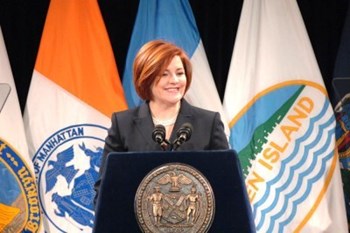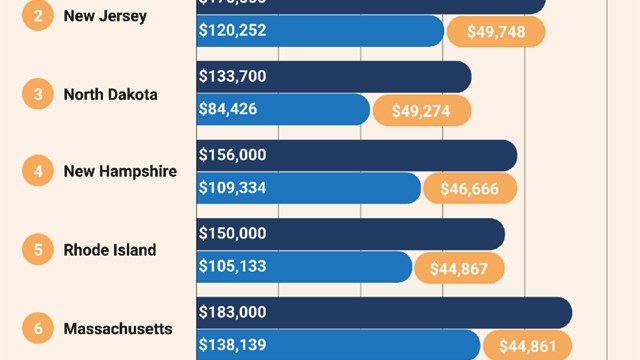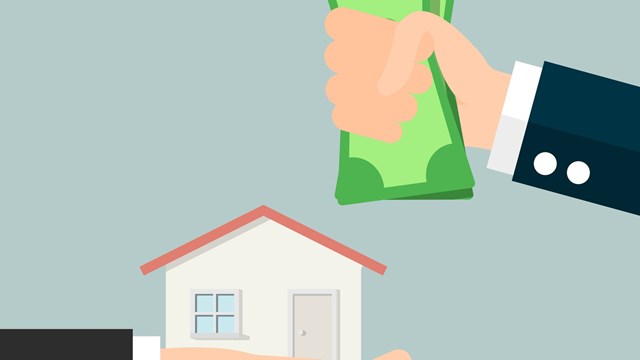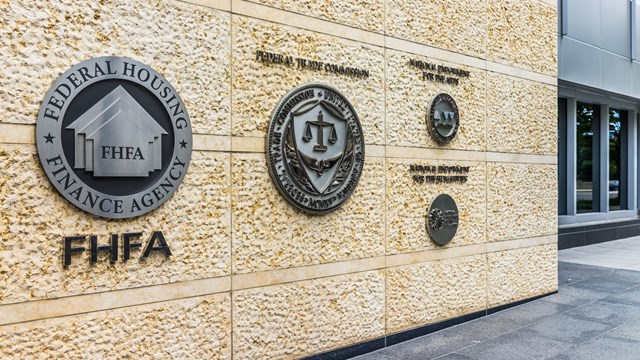
You would think that trying to get to know the city's first female Speaker, Christine Quinn, would be difficult when you've only been granted ten minutes in the demanding politician's day. However, in such a short timeframe, Quinn has enough time to come across as focused, passionate, confident and proud of her achievements since taking office in January 2006. She also readily admits and recognizes the challenges that she still faces, especially on the topic of affordable housing.
Her political career is one that she's been prepping for since she was a young child. Growing up in Glen Cove, Long Island, Quinn was more interested in reading biographies on famous politicians than novels or comic books, and she knew that politics was her calling.
"It was the only thing I was ever interested in; I don't remember wanting to do anything else," she says. "The people involved were fascinating and interesting characters. I read biographies and books on history and how it got made and who made it."
Quinn served as representative for the 3rd Council District of Manhattan from 1999 to 2006. She has also served as chief of staff to Council Member Thomas K. Duane and worked as executive director of the New York City Gay and Lesbian Anti-Violence Project.
Today, she's diligently working to carve her own place in New York political history, starting with being the first woman, who is also openly gay, as city speaker. In her February state-of-the-city address, Quinn quotes one of America's greatest ballplayers, the Brooklyn Dodgers' Jackie Robinson, and says, "A life isn't significant except for its impact on other lives."
Quinn is working hard to protect and enhance the lives of city workers and its residents. Last year, she successfully campaigned for 18,000 police officers to have the best bulletproof vests money can buy, what she calls "my proudest moment in my first year in office."
She has also championed full-day pre-K for four-year olds with more than 2,100 new full-day slots created—a boon to working parents—and 2,100 more proposed for this year. She fought against an earlier proposal to build a stadium on the West Side and instead changed the use of the site to include building of affordable housing, park space and other commercial development. She has also campaigned to increase funding for all three library systems—a proposed $43 million dollars.
The Struggle for Affordable Housing
Perhaps one of Quinn's biggest challenges in the city is the lack of affordable housing. With skyrocketing real estate and rental prices, New York City is trying to protect its middle and lower class residents. Ironically, Quinn fought for similar affordable housing changes in the late 1980s when she was a tenant organizer. She was part of a citywide coalition that was fighting to improve housing policies in the city to bring more resources to low- and moderate-income people.
"It used to be when you talked about affordable housing back then, you meant low and moderate income and now you mean low, moderate and middle income," says Quinn. "Affordable housing is a big problem and we have to be vigilant in finding ways to deal with it. I wish there was one thing to do to fix it, but the truth is if there were one thing to do, we probably would've done it already. We need to keep working and coming up with ideas and solutions, including preserving the units we already have, and making sure we keep New York economically-diverse."
Over the last few years, however, the city has been met with several challenges in trying to accomplish this, including the pending sale of Starrett City, a working-class enclave of 46 apartment buildings in Brooklyn and the largest federally-subsidized housing project in the country. Tenants, housing advocates and politicians balked at this sale because of the concern that rents would be raised and services cut. An article in The New York Times said that in March, "the federal housing secretary rejected the proposed $1.3 billion sale because the prospective buyer has failed to supply adequate financial information or a plan for how the complex would remain "a viable community for New Yorkers of modest means." The issue is not yet closed.
Similarly, Stuyvesant Town and Peter Cooper Village, 110 apartment buildings along the East River, were sold last year by Met Life to Jerry Speyer, a real estate investor, for $5.4 billion. Tenants fear that the affordable, rent-stabilized apartments will give way to a new, elite luxury market, leaving tenants scrambling for new digs. Speyer assured tenants that this wasn't the case, but only time will tell.
Taxing Taxes
Another issue Quinn must deal with is the disparity between Class 1 and Class 2 residential property in paying property taxes. The real estate property tax is imposed on each of the four different classes of property at varying rates. Class 1 property consists primarily of one, two and three family residential property and small condominiums; Class 2 property consists of all other residential property including cooperatives and condominiums; Class 3 consists of utility real property; and Class 4 consists of all other real property, such as office buildings, factories, stores, lofts and vacant land.
According to the Fiscal Year's 2008 Preliminary Budget, "the long term trend in the high growth of market value for Class 1 properties, along with the effects of the state-mandated class share system, have produced steady increases in Class 1's tax rate." The response explains that since Fiscal Year 2002, over the five-year period ending in Fiscal Year 2007, Class 1's tax rate has grown by nearly 39 percent and there may be a substantial increase in Class 1's tax rate again in Fiscal Year 2008.
"The mayor has proposed cutting taxes by 5 percent in Fiscal Year 2008. But, when the increase in Class 1's tax rate is combined with the anticipated growth of more than four percent in assessments for Class 1, the increase in the tax bill from last year for most Class 1 owners will not be completely offset by the 5 percent rate cut. However, the renewal of the $400 rebate will eliminate the increase for most taxpayers."
"This is a big problem and something we must address," says Quinn. "We used to say a home is a home, but co-op or condo owners are paying as much property taxes as one-, two- or three-bedroom homes of the same value. The answer isn't to put the difference onto the homeowners though; we need to get some solutions to this."
What's on the Agenda?
Quinn outlined four items on the housing agenda for the future that she feels will help offset these affordable housing troubles, including a tax credit for renters, financial education to prevent foreclosures, assistance for New Yorkers to become first-time homeowners and rehabbing affordable housing.
The Renters Tax Credit will be for families of four making $75,000 or less, and $43,000 for individuals, allowing them to receive a $300 refundable income tax credit.
"Under current city programs, families making less than 80 percent of area median income (for a family of four, currently $56,720 a year) can receive help paying closing costs and down payments," explains Quinn. "The Renters to Owners Opportunity Fund (ROOF) would create a new program for families who make up to 130 percent of area median income ($92,170 a year for a family of four)."
Quinn explains that the council would also link New York to responsible lenders through counseling programs, thereby helping to eliminate risks, such as the recent sub-prime mortgage risk, that led to an 18 percent increase in foreclosures.
"Finally, a significant inventory of federally-subsidized housing is in poor physical and financial condition," explains Quinn in her state-of-the-city address. "As a result, HUD may foreclose and sell to the highest bidder, causing a loss of affordable housing. To preserve these housing units, the council is proposing spending city capital dollars toward revitalizing federally-subsidized housing."
Quinn doesn't believe that the affordable housing crisis will be solved during her tenure, but she says, "We hope to make significant progress and take steps to preserve more affordable units."
No job is without its obstacles, but Quinn doesn't see any obstacle as being too big.
"I rarely come across an obstacle so large that if you didn't keep working and discussing you weren't able to overcome it," she says. "What happens is when people leave the negotiating table and leave the room, they've abandoned the search for commonality and that's when you don't find a solution. You need to keep talking, keep listening and don't take no for an answer."
Lisa Iannucci is a freelance writer living in Poughkeepsie, N.Y. and a frequent contributor to The Cooperator.









Leave a Comment